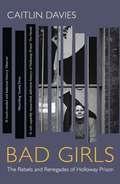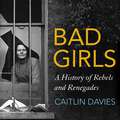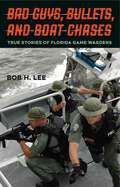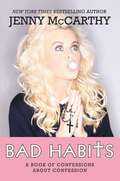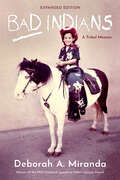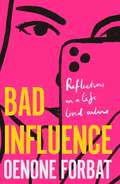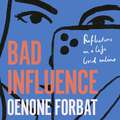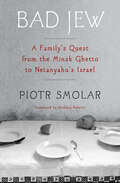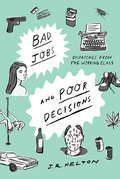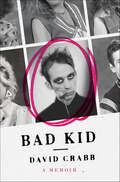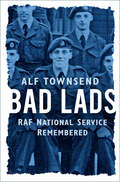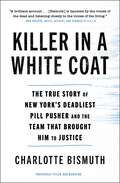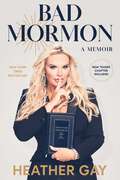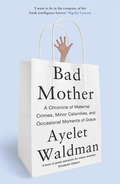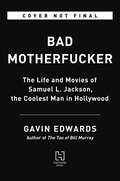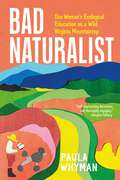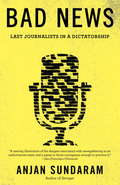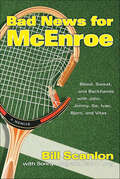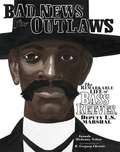- Table View
- List View
Bad Girls: A History of Rebels and Renegades
by Caitlin DaviesLONGLISTED FOR THE 2019 ORWELL PRIZE FOR POLITICAL WRITING'Davies's absorbing study serves up just enough sensationalism - and eccentricity - along with its serious inquiry' SUNDAY TIMES'[A] revealing account of the jail's 164-year history' DAILY TELEGRAPH, 5* review'Insightful and thought-provoking and makes for a ripping good read' JEREMY CORBYN'A much-needed and balanced history' OBSERVER'Davies explores how society has dealt with disobedient women - from suffragettes to refugees to women seeking abortions - for decades, and how they've failed to silence those who won't go down without a fight' STYLISTSociety has never known what to do with its rebellious women. Those who defied expectations about feminine behaviour have long been considered dangerous and unnatural, and ever since the Victorian era they have been removed from public view, locked up and often forgotten about. Many of these women ended up at HM Prison Holloway, the self-proclaimed 'terror to evil-doers' which, until its closure in 2016, was western Europe's largest women's prison. First built in 1852 as a House of Correction, Holloway's women have come from all corners of the UK - whether a patriot from Scotland, a suffragette from Huddersfield, or a spy from the Isle of Wight - and from all walks of life - socialites and prostitutes, sporting stars and nightclub queens, refugees and freedom fighters. They were imprisoned for treason and murder, for begging, performing abortions and stealing clothing coupons, for masquerading as men, running brothels and attempting suicide. In Bad Girls, Caitlin Davies tells their stories and shows how women have been treated in our justice system over more than a century, what crimes - real or imagined - they committed, who found them guilty and why. It is a story of victimization and resistance; of oppression and bravery. From the women who escaped the hangman's noose - and those who didn't - to those who escaped Holloway altogether, Bad Girls is a fascinating look at how disobedient and defiant women changed not only the prison service, but the course of history.
Bad Girls: A History of Rebels and Renegades
by Caitlin DaviesLONGLISTED FOR THE 2019 ORWELL PRIZE FOR POLITICAL WRITINGA history of a century of women, punishment and crime in HM Prison Holloway.Society has never known what to do with its rebellious women. Those who defied expectations about feminine behaviour have long been considered dangerous and unnatural, and ever since the Victorian era they have been removed from public view, locked up and often forgotten about. Many of these women ended up at HM Prison Holloway, the self-proclaimed 'terror to evil-doers' which, until its closure in 2016, was western Europe's largest women's prison. First built in 1852 as a House of Correction, Holloway's women have come from all corners of the UK - whether a patriot from Scotland, a suffragette from Huddersfield, or a spy from the Isle of Wight - and from all walks of life - socialites and prostitutes, sporting stars and nightclub queens, refugees and freedom fighters. They were imprisoned for treason and murder, for begging, performing abortions and stealing clothing coupons, for masquerading as men, running brothels and attempting suicide. In Bad Girls, Caitlin Davies tells their stories and shows how women have been treated in our justice system over more than a century, what crimes - real or imagined - they committed, who found them guilty and why. It is a story of victimization and resistance; of oppression and bravery. From the women who escaped the hangman's noose - and those who didn't - to those who escaped Holloway altogether, Bad Girls is a fascinating look at how disobedient and defiant women changed not only the prison service, but the course of history.(P)2018 Hodder & Stoughton Limited
Bad Girls: Sirens, Jezebels, Murderesses, Thieves & Other Female Villains
by Jane Yolen Heidi E. Y. StempleFrom Jezebel to Catherine the Great, from Cleopatra to Mae West, from Mata Hari to Bonnie Parker, strong women have been a problem for historians, storytellers, and readers. Strong females smack of the unfeminine. They have been called wicked, wanton, and willful. Sometimes that is a just designation, but just as often it is not. "Well-behaved women seldom make history," is the frequently quoted statement by historian and feminist Laurel Thatcher Ulrich. But what makes these misbehaving women "bad"? Are we idolizing the wicked or salvaging the strong? In BAD GIRLS, readers meet twenty-six of history's most notorious women, each with a rotten reputation. But authors Jane Yolen and Heidi Stemple remind us that there are two sides to every story. Was Delilah a harlot or hero? Was Catherine the Great a great ruler, or just plain ruthless? At the end of each chapter, Yolen and Stemple appear as themselves in comic panels as they debate each girl's badness--Heidi as the prosecution, Jane for context. This unique and sassy examination of famed, female historical figures will engage readers with its unusual presentation of the subject matter. Heidi and Jane's strong arguments for the innocence and guilt of each bad girl promotes the practice of critical thinking as well as the idea that history is subjective. Rebecca Guay's detailed illustrations provide a rich, stylized portrait of each woman, while the inclusion of comic panels will resonate with fans of graphic novels.
Bad Guys, Bullets, and Boat Chases: True Stories of Florida Game Wardens
by Bob H. Lee“Stories are brimming with confrontations and high-stakes action. . . . Lee’s observations radiate authenticity and he effectively conveys his sophisticated knowledge base about the law, the Everglades and the criminal mind and the skill sets of conservation professionals. Once you get into this book, you won’t be able to put it down.”—Florida Weekly “Engaging, humorous, and touching. As we meet this crazy real-life cast, Lee shows us that the true character of those on the frontlines of the fight against wildlife crime is integrity and a commitment to protect animals and landscapes.”—Laurel A. Neme, author of Animal Investigators: How the World’s First Wildlife Forensics Lab Is Solving Crimes and Saving Endangered Species “The job of a wildlife officer is never boring. Lee takes you behind the scenes on patrol—using everything from airboats to airplanes—as he and other state wildlife officers track and apprehend poachers in the Sunshine State.”—W. H. “Chip” Gross, coauthor of Poachers Were My Prey: Eighteen Years as an Undercover Wildlife Officer “Lee’s enlightening and entertaining stories will open your eyes to the duties and responsibilities that these officers perform on any given day.”—Dave Grant, past president, North American Game Warden Museum “Lee provides remarkable insight into a world and culture unknown to most people, revealing the true diversity and dangers of the game warden profession.”—Craig Hunter, director of law enforcement, Texas Parks and Wildlife “These stories convey the feel of the Florida environment, the tedium of the hiding and waiting, the thrill of the chase and capture, and the exhaustion, exhilaration, or heartbreak of the search and rescue. You won’t be disappointed.”—James “Tom” Mastin, consulting forester and principal, Natural Resource Planning Services, Inc. Imagine yourself alone in the wilderness holding two lawbreaking suspects at gunpoint. No onlookers, no backup. Just you in the dark, in the middle of nowhere, with suspects who would cheerfully kill you if they thought they could get away with it. Veteran wildlife officer Bob Lee takes readers deep into the days and nights of Florida game wardens in Bad Guys, Bullets, and Boat Chases. Some people might think that all these officers do is check fishing licenses, but this book tells a very different story, one of shoot-outs, survival, rescue, and powerboat chases. Tracking black-market gator poachers, jumping through truck windows, shredding boat propellers on underwater logs, trapping airboats in wild hog muck, ferrying crates of baby sea turtles, hunting for missing persons in remote areas, getting stuck under a 500-pound all-terrain vehicle at the bottom of a sinkhole—these are just some of the situations game wardens find themselves in. And beyond the action and excitement, the highs and lows of a wildlife officer’s job would test the mental limits of even the bravest adventurer. In these stories, a rookie game warden works to rescue survivors after a jumbo jet crashes in a swamp; an experienced trapper leads a challenging search for a rogue gator after a tragic attack; and a dedicated lieutenant helps a deer poacher turn his life around. From Live Oak to the Everglades, from the cattle ranches west of Lake Okeechobee to the inshore fishing grounds of Pine Island, these amazing experiences span the state. Discover the excitement, dangers, and disasters that game wardens face every day on the job.
Bad Habits: A Book of Confessions about Confession
by Jenny MccarthyJenny McCarthy--actress, comedian, activist, and New York Times bestselling author--candidly recounts her humorous Catholic upbringing, from her childhood dream of becoming a nun to her Playmate of the Year centerfold, and all of the Hail Mary's in between.In keeping with the theme of her comedic New York Times bestsellers, from Belly Laughs to Love, Lust & Faking It, McCarthy brings her trademark honesty, humility, and humor to bear as she chronicles her often embarrassing, occasionally outlandish, and always entertaining life as a born-and-raised Catholic girl.Jenny attended one of the most prestigious all-girl Catholic schools in Chicago. While most young girls in Jenny's neighborhood were playing with Cabbage Patch dolls for fun, Jenny was playing with Jesus, Mary, and Joseph dolls. She had every intention of growing up and becoming a nun, but a few hilarious speed bumps and blinking red lights along the way changed her mind. Jenny never did accept Sister Mary's reasoning that she could avoid purgatory if she just bought a string necklace for $10. The fact that two of her aunts are simultaneously nuns and cops-yes, they carry guns and shoot people while wearing a habit-never made complete sense to her. And neither does her mother's insistence that Jenny bury certain religious statues in the front lawns of her houses before she sells them. But then again, Jenny does have four of them buried across Southern California.This book tells the story of what went wrong during Jenny's Catholic upbringing, or, as Jenny puts it now, what went right. Chapters include: "I Knew I Should Have Worn Underwear to Church", "Jesus' Baby Mama", "Can Someone Kill Our Dog, Please?", and "Oh No, My Mom is Going to Hell."BAD HABITS is a brutally honest, hilarious memoir that will delight the legions of Jenny McCarthy fans.
Bad Henry: The Murderous Rampage of ‘The Taco Bell Strangler'
by Ron ChepesiukHenry Louis Wallace terrorized Charlotte, North Carolina, from May 1992 to March 1994. Wallace preyed on lower economic-class Black women between 17 and 35 years old. He knew most of his victims, some through his job at Taco Bell, and gained their trust with his friendly demeanor and gentle nature—concealing a monster fueled by drug abuse and rage against women. A rarity in that he was an African American serial killer, his murderous rampage spurred controversy throughout the city. Community members accused local police of ignoring the murders because of the victims' race. Wallace attended the funerals of many of his victims and offered condolences to families. The ensuing investigation became the largest in North Carolina’s history. Wallace was eventually found guilty and convicted of nine counts of murder, but he admitted to more killings while incarcerated; he is potentially responsible for anywhere from 20 to 90 deaths of Black women. Wallace continues to appeal and awaits his execution at Central Prison in Raleigh. BAD HENRY: The Murderous Rampage of ‘The Taco Bell Strangler’ by Ron Chepesiuk offers valuable insight into the psychology of serial killers and sheds light on issues surrounding race and policing.
Bad Indians (Expanded Edition): A Tribal Memoir
by Deborah MirandaNewly expanded, a memoir hailed as essential by the likes of Leslie Marmon Silko and ELLE magazine."Bad Indians stands out as a classic quintessentially Indigenous memoir. " —Joy HarjoBad Indians—part tribal history, part lyric and intimate memoir—is essential reading for anyone seeking to learn about California Indian history, past and present. Widely adopted in classrooms and book clubs throughout the United States, Bad Indians—now reissued in significantly expanded form—plumbs ancestry, survivance, and the cultural memory of Native California.In this best-selling, now-classic memoir, Deborah A. Miranda tells stories of her Ohlone/Costanoan-Esselen family and the experiences of California Indians more widely through oral histories, newspaper clippings, anthropological recordings, personal reflections, and poems. This expanded edition—the first time the book has seen release in hardcover format—includes new poems and essays, as well as an extensive afterword. Wise, indignant, and playful all at once, Bad Indians is a beautiful and devastating read, and an indispensable book for anyone seeking a more just telling of American history.
Bad Influence: The buzzy debut memoir about growing up online
by Oenone Forbat'An ideal summer read' EVENING STANDARD'Equal parts insightful and entertaining - whatever your take on influencers, Bad Influence is a great read' YOMI ADEGOKEOenone didn't set out to become an influencer. The word barely existed when she started posting on Instagram at university to document her 'fitness journey' after a toxic relationship came to a messy end.In this humorous meditation on her digitized life, Oenone chronicles the pits and peaks of coming of age online. Grappling with modern-day issues on a public stage - from body image and personal boundaries to the limitations of online activism, Bad Influence examines what happens when your day-to-day reality becomes #content - and that #content pays your bills.It asks: can you truly be authentic online? Can social media be a force for good? Is it necessarily bad for our mental health?Written with wit, warmth and honesty, this is a candid account of what it really means to be an influencer, from someone still figuring it out: the good, the bad and the instagrammable.'Warm, juicy, and eye-opening, like having a chat with a best friend' ANNIE LORD'If ever a book captured the zeitgeist, this is it' GRACE CAMPBELL'Funny, warm and brilliantly engaging' LUCY VINE
Bad Influence: The hotly-anticipated debut memoir about growing up online - 'An ideal summer read' EVENING STANDARD
by Oenone ForbatA smart, humorous and candid account of coming of age on the internet, from the much-loved online personality Oenone Forbat.'I have spent most of my adult life online, so much so that it can be hard to know which parts of me are the 'real' me and which parts I have subconsciously edited, facetuned and perhaps exaggerated, to suit being so hyper-visible'Oenone didn't set out to become an influencer. The word barely existed when she started posting on Instagram at university to document her 'fitness journey' after a toxic relationship came to a messy end.In this humorous meditation on her digitized life, Oenone chronicles the pits and peaks of coming of age online. Grappling with modern-day issues on a public stage - from body image and personal boundaries to the limitations of online activism, Bad Influence examines what happens when your day-to-day reality becomes #content - and that #content pays your bills.It asks: can you truly be authentic online? Can social media be a force for good? Is it necessarily bad for our mental health?Written and narrated with wit, warmth and honesty, this is a candid account of what it really means to be an influencer, from someone still figuring it out: the good, the bad and the instagrammable.(P)2023 Quercus Editions Limited
Bad Influence: The hotly-anticipated debut memoir about growing up online - 'An ideal summer read' EVENING STANDARD
by Oenone Forbat'An ideal summer read' EVENING STANDARD'Equal parts insightful and entertaining - whatever your take on influencers, Bad Influence is a great read' YOMI ADEGOKEOenone didn't set out to become an influencer. The word barely existed when she started posting on Instagram at university to document her 'fitness journey' after a toxic relationship came to a messy end.In this humorous meditation on her digitized life, Oenone chronicles the pits and peaks of coming of age online. Grappling with modern-day issues on a public stage - from body image and personal boundaries to the limitations of online activism, Bad Influence examines what happens when your day-to-day reality becomes #content - and that #content pays your bills.It asks: can you truly be authentic online? Can social media be a force for good? Is it necessarily bad for our mental health?Written with wit, warmth and honesty, this is a candid account of what it really means to be an influencer, from someone still figuring it out: the good, the bad and the instagrammable.'Warm, juicy, and eye-opening, like having a chat with a best friend' ANNIE LORD'If ever a book captured the zeitgeist, this is it' GRACE CAMPBELL'Funny, warm and brilliantly engaging' LUCY VINE
Bad Jew: A Familys Quest from the Minsk Ghetto to Netanyahus Israel
by Piotr SmolarCombining memoir, history, and political essay, an acclaimed French journalist delves into his family&’s past in this searing, nuanced investigation of Jewish identity and what it means in the diaspora versus Israel today.What is a Jew? There are as many answers as there are Jewish people.Written four years ago, and now available in English with a new introduction, Bad Jew speaks intelligently to our current crises. A striking portrait of the identity fever that has overtaken the Israeli right, and a moving family saga, it follows three generations, three Jewish men, each involved in public life in his own personal way: Piotr Smolar&’s grandfather, a passionate Polish communist, who led the resistance in the Minsk ghetto during World War II; Smolar&’s father, who opposed the communist regime in Poland in 1968 and had to flee the country; and Smolar himself, confronted with the question of Jewish identity after becoming Le Monde&’s correspondent in Jerusalem.Deftly interweaving their stories of activism and migration, Smolar explores how tribalism harms democracy and asks difficult questions: when does loyalty turn into betrayal? What place is left for basic values and empathy? This important book has never been timelier.
Bad Jobs and Poor Decisions: Dispatches From The Working Class
by J. R. HeltonWeaving the brackish humor of Chuck Palahniuk’s Fight Club with the empathy of Barbara Ehrenreich’s Nickel and Dimed, J. R. Helton brings to life an obscured, all-too-often ignored slice of the American psyche in this unflinching memoir of blue-collar Texas. In the 1980s, somewhere in Austin, Helton was young, married, and jobless. After a few strung-out years trying to make it as a writer, he was caught in a cycle of drunken, coked-up nights, crashing on friends’ couches and looking for money in the morning. Succumbing to the daunting reality of what it means to support both himself and a troubled marriage, he became a housepainter. He sold pumpkins on the side of the road, delivered firewood, ran a crew of illegal immigrants hauling railroad ties across the empty plains of Kansas, and then he painted even more. Despair is transformed into resilience as Helton insightfully narrates his wayward years, enduring hateful employers and mind-numbing manual labor. Along the way, the people toiling beneath the saccharine veneer of wealth that was the Reagan years are brought to vivid life: the ambitious and the lazy, the potheads and the racists, as well as Vietnam vets too shaken to hold a paintbrush and deadbeat fathers straining to pay child support. With intoxicating, blasé-faire sentiment, Helton shows that everyone—from the beauties at the rodeo to the lowest laborers—is tethered by a common desire to just pay the bills and balm the loneliness. A raw and moving account, Bad Jobs and Poor Decisions captures a microcosm of left-behind America that straddles a dangerous line between ruin and redemption.
Bad Kid: A Memoir
by David CrabbFrom comedian, storyteller, and The Moth host David Crabb, comes a music-filled, coming-of-age memoir about growing up gay and Goth in San Antonio, Texas. In the summer of 1989, three Goth kids crossed a street in San Antonio. They had no idea that a deeply confused fourteen-year-old boy was watching. Their dyed hair, fishnets, and eyeliner were his first evidence of another world—a place he desperately wanted to go. He just had no idea how to get there.Somehow David Crabb had convinced himself that every guy preferred French-braiding his girlfriend’s hair to making out, and that the funny feelings he got watching Silver Spoons and Growing Pains had nothing to do with Ricky Schroeder or Kirk Cameron. But discovering George Michael’s Faith confirmed for David what every bully already knew: he was gay. Surviving high school, with its gym classes, locker rooms, and naked, glistening senior guys, would require impossible feats of denial. What saved him was finding a group of outlandish friends who reveled in being outsiders. David found himself enmeshed with misfits: wearing black, cutting class, staying out all night, drinking, tripping, chain-smoking, idolizing The Smiths, Pet Shop Boys, and Joy Division—and learning lessons about life and love along the way. Richly detailed with 80s pop-culture, and including black and white photos throughout, BAD KID is as laugh-out-loud funny as it is poignant. Crabb’s journey through adolescence captures the essence of every person’s struggle to understand his or her true self.
Bad Lads: RAF National Service Remembered
by Alf TownsendBetween 1945 and 1963, more than 2.5 million 18-year-olds were called up for National Service. Alf Townsend was one of them, and here he tells his story - the highs and lows of life as a lowly Aircraftman Second Class in the early 1950s.Before national service intervened, Alf was 'heading down the criminal road at top speed', having grown up in a north London slum, where money was short and local villains were revered. Bad Lads is a warts-and-all account of Alf's time in the RAF, when he was transplanted into a completely new world of misfits and officer types, rogues and entertainers, all amusingly described in his own inimitable style.
Bad Lawyer: A Memoir of Law and Disorder
by Anna DornLaw school was never Anna Dorn's dream. It was a profession pushed on her by her parents, teachers, society... whatever. It's not the worst thing that can happen to a person; as Dorn says, law school was pretty "cushy" and mostly entailed wearing leggings every day to her classes at Berkeley and playing beer pong with her friends at night. The hardest part was imagining what it would be like to actually be a lawyer one day. But then she'd think of Glenn Close on Damages and Reese Witherspoon in Legally Blonde, and hoped for the best.After graduation, however, Dorn realized that there was nothing sexy about being a lawyer. Between the unflattering suits, sucking up to old men, and spending her days sequestered in a soul-sucking cubicle, Dorn quickly learned that being a lawyer wasn't everything Hollywood made it out to be. Oh, and she sucked at it. Not because she wasn't smart enough, but because she couldn't get herself to care enough to play by the rules.Bad Lawyer is more than just a memoir of Dorn's experiences as a less-than-stellar lawyer; it's about the less-than-stellar legal reality that exists for all of us in this country, hidden just out of sight. It's about prosecutors lying and filing inane briefs that lack any semblance of logic or reason; it's about defense attorneys sworn to secrecy-until the drinks come out and the stories start flying; and it's about judges who drink in their chambers, sexually harass the younger clerks, and shop on eBay instead of listening to homicide testimony. More than anything, this book aims to counteract the fetishization of the law as a universe based entirely on logic and reason. Exposing everything from law school to law in the media, and drawing on Dorn's personal experiences as well as her journalistic research, Bad Lawyer ultimately provides us with a fresh perspective on our justice system and the people in it, and gives young lawyers advice going forward into the 21st century.
Bad Medicine: Catching New York's Deadliest Pill Pusher
by Charlotte Bismuth&“Charlotte Bismuth gives us a bold and cinematic true crime story about her work at the intersection of medicine and greed. Bad Medicine is a gripping memoir that toggles deftly between the personal and prosecutorial.&” —Beth Macy, New York Times bestselling author of Dopesick &“Bismuth has written a brilliant account of prosecuting a doctor who became a drug dealer in a white coat. She is haunted by the voices of the dead and listening closely to the voices of the living.&” —Nan Goldin, artist, activist, and founder of P.A.I.N. &“Bad Medicine is a taut exploration of America&’s deadly battle with opioid addiction—an unnerving and inspirational firecracker of a book.&” —Karen Abbott, New York Times bestselling author of The Ghosts of Eden Park For fans of Dopesick and Bad Blood, the shocking story of New York&’s most infamous pill-pushing doctor, written by the prosecutor who brought him down.In 2010, a brave whistleblower alerted the police to Dr. Stan Li&’s corrupt pain management clinic in Queens, New York. Li spent years supplying more than seventy patients a day with oxycodone and Xanax, trading prescriptions for cash. Emergency room doctors, psychiatrists, and desperate family members warned him that his patients were at risk of death but he would not stop. In Bad Medicine, former prosecutor Charlotte Bismuth meticulously recounts the jaw dropping details of this criminal case that would span four years, culminating in a landmark trial. As a new assistant district attorney and single mother, Bismuth worked tirelessly with her team to bring Dr. Li to justice. Bad Medicine is a chilling story of corruption and greed and an important look at the role individual doctors play in America&’s opioid epidemic.
Bad Medicine: The Horrors of American Healthcare
by Dr. Stephen SolowayWhat you don&’t know about the American healthcare system might kill you. From fatal malpractice to Medicare fraud, Dr. Stephen Soloway has seen it all over his thirty years practicing medicine. Now, the man known as &“Dr. Trump&” is ripping off the Band-Aid and exposing the truth about the American healthcare system—the good, the bad, and the rotten. Page after shocking page, you&’ll discover the truth about where the coronavirus came from, and if we&’ll ever be able to cure it. Learn the sad reality of what Medicare for All would mean for our nation. Find out why you should stay away from hospitals as if your life depended on it. (It does.) Dr. Soloway explains the medical tips and tricks that could save you from amputations, years of pain, or even death. Appointed by President Donald Trump to the President's Council on Sports, Fitness, and Nutrition, Dr. Soloway is a leader in his field, who sat on numerous boards and panels in the pharmacological industry, along with national advisory panels for major companies involved in arthritis or osteoporosis research. His uncanny ability to diagnose even the most complex cases has earned him the reputation of being a real-life Dr. House—minus the pill problem. Beyond his savvy insights into the secrets of our medical system, Dr. Soloway also shares his own rags to riches story, and how dedicated medical professionals can still succeed in this difficult environment. Ultimately, Dr. Soloway has a diagnosis for all Americans: Our healthcare system—and our country as a whole—is headed for disaster. The prescription? Read this book to find out.
Bad Mormon: A Memoir
by Heather GayINSTANT NEW YORK TIMES BESTSELLER Named one of Entertainment Tonight&’s Best Celebrity Memoirs of 2023 As seen in The New York Times, People, The Cut, Vulture, The Daily Beast, Today, Bustle, Us Weekly, Life & Style, and Interview &“No stone goes unturned&” (People) in this memoir about The Real Housewives of Salt Lake City star Heather Gay&’s departure from the Mormon Church, and her unforeseen success in business, television, and single motherhood.Straight off the slopes and into the spotlight, Heather Gay is famous for speaking the gospel truth. Whether as a businesswoman, mother, or television personality, she is unafraid to blaze a new trail, even if it means losing family, friends, and her community. Born and bred to be devout, Heather based her life around her faith. She attended Brigham Young University, served a mission in France, and married into Mormon royalty in the temple. But her life as a good Mormon abruptly ended when she lost the marriage and faith that she had once believed would last forever. With writing that is beautiful, sad, funny, and true, Heather recounts the difficult discovery of the darkness and damage that often exists behind a picture-perfect life, while examining the nuanced relationship between duty to self and duty to God. &“An eye-opening firsthand account of religious indoctrination told with candor and sincerity&” (Interview magazine), Bad Mormon is an unfiltered look at the religion that broke her heart.
Bad Mother: A Chronicle of Maternal Crimes, Minor Calamities, and Occasional Moments of Grace
by Ayelet Waldman'I want to be in the company of her frank intelligence forever' Nigella LawsonIn our mothers' day there were good mothers, indifferent mothers, and occasionally, great mothers. Today we have only Bad Mothers: If you work, you're neglectful; if you stay home, you're smothering. If you discipline, you're buying them a spot on the shrink's couch; if you let them run wild, they will be into drugs by seventh grade. Is it any wonder so many women refer to themselves at one time or another as a "bad mother"?Writing with remarkable candor, and dispensing much hilarious and helpful advice along the way--Is breast best? What should you do when your daughter dresses up as a "ho" for Halloween?--Ayelet Waldman says it's time for women to get over it and get on with it in this wry, unflinchingly honest, and always insightful memoir on modern motherhood.
Bad Motherfucker: The Life and Movies of Samuel L. Jackson, the Coolest Man in Hollywood
by Gavin EdwardsA fascinating exploration and celebration of the life and work of the coolest man in Hollywood, Samuel L. Jackson—from his star-making turns in the films of Spike Lee and Quentin Tarantino to his ubiquitous roles in the Star Wars and Marvel franchises, not to mention the cult favorite Snakes on a Plane.Samuel L. Jackson&’s embodiment of cool isn&’t just inspirational—it&’s important. Bad Motherfucker lays out how his attitude intersects with his identity as a Black man, why being cool matters in the modern world, and how Jackson can guide us through the current cultural moment in which everyone is losing their cool. Edwards details Jackson&’s fascinating personal history, from stuttering bookworm to gunrunning revolutionary to freebasing addict to A-list movie star.Drawing on original reporting and interviews, the book explores not only the major events of Jackson&’s life but also his obsessions: golf, kung fu movies, profanity. Bad Motherfuckerfeatures a delectable filmography of Jackson&’s movies—140 and counting!—and also includes new movie posters for many of Jackson&’s greatest roles, reimagined by dozens of gifted artists and designers. The book provides a must-read road map through the vast territory of his on-screen career and more: a vivid portrait of Samuel L. Jackson&’s essential self, as well as practical instructions, by example, for how to live and work and be.
Bad Naturalist: One Woman's Ecological Education on a Wild Virginia Mountaintop
by Paula WhymanWith humor, humility, and awe, one woman attempts to restore 200 acres of farmland long gone-to-seed in the Blue Ridge Mountains, facing her own limitations while getting to know a breathtaking corner of the natural world. When Paula Whyman first climbs a peak in the foothills of the Blue Ridge Mountains in search of a home in the country, she has no idea how quickly her tidy backyard ecology project will become a massive endeavor. Just as quickly, she discovers how little she knows about hands-on conservation work. In Bad Naturalist, readers meander with her through orchards and meadows, forests and frog ponds, as she is beset by an influx of invasive species, rattlesnake encounters, conflicting advice from experts, and delayed plans—but none of it dampens her irrepressible passion for protecting this place. With delightful, lyrically deft storytelling, she shares her attempts to coax this beautiful piece of land back into shape. It turns out that amid the seeming chaos of nature, the mountaintop is teeming with life and hope.
Bad News
by Anjan SundaramAuthor of the acclaimed Stringer, praised by Jon Stewart as "a remarkable book about the lives of people in the Congo," Anjan Sundaram returns to Africa for a piercing look at Rwanda, a country still caught in political and social unrest years after the genocide that shocked the world. Bad News is the story of Anjan Sundaram's time teaching a class of journalists in Kigali, the capital city of Rwanda. The current Rwandan regime, which seized power after the genocide in 1994, is often held up as a beacon of progress and is the recipient of billions of dollars each year in aid from Western governments. Underpinning this shining vision of a modern orderly state, however, is a powerful climate of fear springing from the government's brutal treatment of any voice of dissent. "You cannot look and write," a policeman tells Sundaram as he takes notes at a political rally. As Sundaram's students are exiled, imprisoned, recruited as well-paid propagandists, and even shot, he tries frantically to preserve a last bastion of debate in a country where the testimony of the individual is crushed by the ways of thinking prescribed by Paul Kagame's dictatorial regime. A vivid portrait of a country at an extraordinary and dangerous place in its history, Bad News is a brilliant and urgent parable on the necessity of freedom of expression and what happens when that freedom is seized.From the Hardcover edition.
Bad News
by Anjan SundaramThe author of the acclaimed Stringer: A Reporter's Journey in the Congo now moves on to Rwanda for a gripping look at a country caught still in political and social unrest, years after the genocide that shocked the world. Bad News is the story of Anjan Sundaram's time running a journalist's training program out of Kigali, the capital city of one of Africa's most densely populated countries, Rwanda. President Kagame's regime, which seized power after the genocide that ravaged its population in 1994, is often held up as a beacon for progress and modernity in Central Africa and is the recipient of billions of dollars each year in aid from Western governments and international organizations. Lurking underneath this shining vision of a modern, orderly state, however, is the powerful climate of fear springing from the government's brutal treatment of any voice of dissent. "You can't look and write," a policeman ominously tells Sundaram, as he takes notes at a political rally. In Rwanda, the testimony of the individual--the evidence of one's own experience--is crushed by the pensée unique: the single way of thinking and speaking, proscribed by those in power. A vivid portrait of a country at an extraordinary and dangerous place in its history, Bad News is a brilliant and urgent parable on freedom of expression, and what happens when that power is seized.
Bad News for McEnroe: Blood, Sweat, and Backhands with John, Jimmy, Ilie, Ivan, Bjorn, and Vitas—A Memoir
by Cathy Long Bill Scanlon Sonny LongA shockingly honest memoir about life on the pro tennis circuit during its golden years by one of McEnroe's and Connors' chief rivals, Bill Scanlon.In the golden age of tennis, when players were just learning how to become media personalities, men like John McEnroe, Jimmy Connors, Björn Borg and Ivan Lendl ruled the court. In a tell-all memoir, former top 10 seeded tennis star and chief McEnroe rival, Bill Scanlon, presents an unfettered look at the good old days of tennis when some of the most colorful (and infamous) players in history went head-to-head and the game was changed forever.Bad News For McEnroe is in part a revelation of the feud between McEnroe and the author that began when they were teenagers, but the essence of this book are the wonderful and surprising on- and off-the-court high jinks of such notable players as Guillermo Vilas, Borg, McEnroe, Ilie Nastase and Connors, all of whom Scanlan played and knew intimately, from locker room fights to on-court breakdowns and blow-ups. A story that could not have come from anyone but a true insider, Scanlon's tale of life on the pro tennis circuit will shock and delight tennis fans everywhere.
Bad News for Outlaws: The Remarkable Life of Bass Reeves, Deputy U.S. Marshal
by Vaunda Micheaux NelsonBASS REEVES ...<P><P> "One of the bravest men this country has ever known."<P> "The most feared deputy U.S. Marshal that was ever heard of."<P> One of the first black deputy U.S. marshals west of the Mississippi.<P> Sitting tall in the saddle, with a wide-brimmed black hat and twin Colt pistols on his belt, Bass Reeves seemed bigger than life. Outlaws feared him. Law-abiding citizens respected him. As a peace officer, he was cunning and fearless. When a lawbreaker heard Bass Reeves had his warrant, he knew it was the end of the trail, because Bass always got his man, dead or alive. He achieved all this in spite of some whites who didn't like the notion of a black lawman.<P> Born into slavery in 1838, Bass had a hard and violent life, but he also had a strong sense of right and wrong that others admired. When Judge Isaac Parker tried to bring law and order to lawless Indian Territory, he chose Bass to be a deputy U.S. marshal. Bass would quickly prove a smart choice.<P> For three decades, Bass was the most feared and respected lawman in the territories. He made more than 3,000 arrests, and though he was a crack shot and a quick draw, he killed only fourteen men in the line of duty. The story of Bass Reeves is the story of a remarkable African American and a remarkable hero of the Old West.<P> Winner of the Coretta Scott King Medal
